

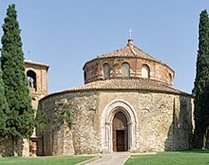
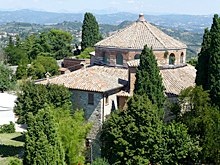
This circular temple dedicated to St Michael Archangel is one of the oldest churches in Umbria. Its circular plan is redolent of Santo Stefano Rotundo, Rome, which was consecrated in 468. Sant' Angelo probably dates to the time of the Byzantine Duchy of Perugia, which was established in 536.
In 1036, Bishop Andrea donated “Santi Angelo quae est edificata extra portam Perusinae civitatis quae dicitur Pulchra” (Sant’ Angelo, which is built outside the gate of the city of Perugia that is called Beautiful - i.e. Arco Etrusco) to the canons of San Lorenzo. This gate was also known as Porta Sant’ Angelo , and gave its name to the Rione (administrative district) di Porta Sant’ Angelo, which was documented from 1036.
Sant’ Angelo was documented again as a possession of the canons of San Lorenzo in 1306.
In 1487, the Baglioni family fortified it during their war with the Oddi family.
Cardinal Tiberio Crispo restored it in ca. 1547.
The columns that Count Vincenzo Ansidei re-used in the 19th century for the portals of two of his family palaces might have come from Sant’ Angelo.
The church was thoroughly restored in 1948.
Exterior
[More]
The squat campanile to the left was built in the 18th century.
Gothic portal (14th century)
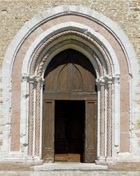
Interior
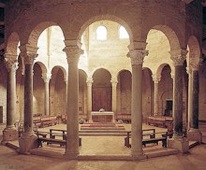
The church comprises two concentric circular spaces separated by a circle of sixteen columns of various materials and dimensions that came from even earlier (presumably pagan) buildings. The floor plan was originally that of a Greek cross. The central dome seems to have been rebuilt in brick in the 14th century, when three of the four chapels that formed the arms of the cross were demolished.
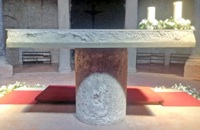
The high altar at the centre of the church is made from an ancient marble slab on a truncated column.
Walk counter-clockwise from the entrance around the outer ring.
Baptistery
This chapel was opened in the 3rd bay in the 14th century.
Frescoes (15th century)
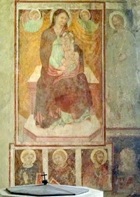
Fresco (15th century)
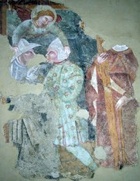
Cappella del Crocifisso
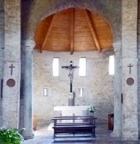
Cappella dell’ Angelo
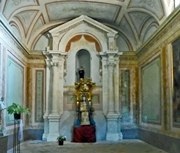
This chapel in the 6th bay seems to have been built soon after the 14th century re-modelling.
Trinity with St Michael and Souls in Purgatory (18th century)
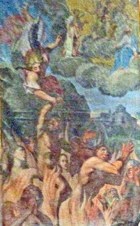
Chapel

12th Bay
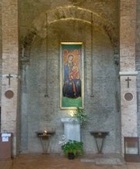
Copy of the Madonna del Verde
A highly venerated fresco of the Madonna and Child (14th century), which was named for the Madonna’s green dress, was originally on a pilaster in the old Duomo. It was transferred to canvas in 1466 and moved to another altar in the Duomo. This altar was demolished in 1849 and the fresco was moved to this altar in Sant’ Angelo. It moved again to the Museo Capitolare in 1979, and was replaced here by a copy.
Roman Base (205 AD)
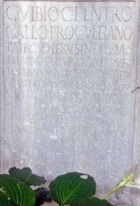
C. Vibio C.f. L.n. Tro(mentina)
Gallo Proculeiano
patrono Perusinorum
patrono et curatori r(ei) p(ublicae)
Vet/tonensium, iudici de V dec(uriis)
aedi/li, patrono collegi centon(ariorum)
Vibius Veldumnianus
avo karissimo, ob cuius
dedicationem dedit
decurionibus ((denarios)) II, plebi ((denarium)) I
L(ocus) d(atus) d(ecreto) d(ecurionum)
This inscription commemorates Gaius Vibius Gallus Proculeianus, the great-grandfather of the future Emperor f Vibius Trebonianus Gallus (251-3 AD). The statue of him that once stood on this base was commissioned by his own “dearest grandfather”, Vibius Veldumnianus. He had been a patron, decurial judge and aedile in Perusia and patron of a guild (perhaps the woolworkers’ guild) there; and also “patronus et curator rei publicae Vettonensium” (defender of the interests of the citizens of Vettona at Rome and treasurer (curator) on behalf of the Roman authorities).
The inscription on the side gives the date:
Dedic(ata) idibus Iul(iis)
Imp(eratore) M(arco) Aurelio Antonino Aug(usto) Pio Fel(ice) II
[et P(ublio) Septimio Geta Severo Caes(are) co(n)s(ulibu)s]
That is, 21st July in the year of the second consulate of the Emperor Caracalla (Marcus Aurelius Severus Antoninus Augustus), which he served with his brother Geta (Publius Septimius Geta Augustus) in 205 AD. The last line of the inscription was erased after Geta was murdered in 211.
Frescoes
SS Agatha, Laurence and Veronica (14th century)
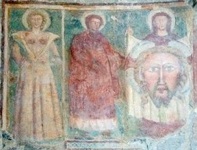
This votive fresco is in the 1st bay. On the left, St Veronica holds her veil, which bears the imprint of the face of Christ.
Other Votive Frescoes (mostly 15th century)
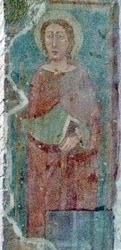
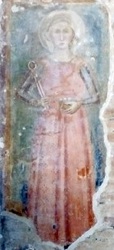
Female saint St Apollonia
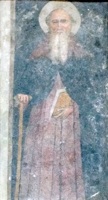
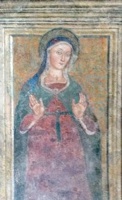

St Antony Abbot Virgin Bishop saint
These include:
-
✴two frescoes on the sides of pilasters:
-
•a female saint, in the 2nd bay; and
-
•St Apollonia, in the 15th bay (who holds her extracted teeth and the instrument with which they had been extracted); and
-
✴three detached frescoes in frames:
-
•St Antony Abbot, in the 7th bay;
-
•the orant Virgin, in the 9th bay; and
-
•a bishop saint, in the 11th bay.

